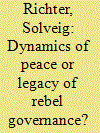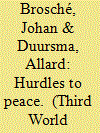|
|
|
Sort Order |
|
|
|
Items / Page
|
|
|
|
|
|
|
| Srl | Item |
| 1 |
ID:
189354


|
|
|
|
|
| Summary/Abstract |
In the academic literature, it is widely accepted that one of the most difficult steps in a peace process is the reincorporation of former combatants. Colombia is a case in point. After the peace agreement with the former rebel group FARC-EP in 2016, the reintegration process of more than 13.000 ex-combatants has been marred with difficulties, be it half-hearted implementation of the stipulations of the accord from the side of the government or the re-armament of some dissident groups. However, the dynamics of the peace process differ considerably between the national and the local level, offering a wide range of pathways from even more violent confrontation up to successful reincorporation projects. In order to explain this variety, we integrate DDR and rebel governance studies and assume that socio-political orders need to be re-configurated when rebel groups have established strong forms of rebel governance, as was the case with the FARC-EP. We argue that patterns of interaction between local conflict-affected communities and ex-combatants are the key explanatory variables for the dynamics of peace processes at local level. We differentiate between clustered and entrenched post-war orders and demonstrate our argument with two case studies based on comprehensive field research.
|
|
|
|
|
|
|
|
|
|
|
|
|
|
|
|
| 2 |
ID:
167952


|
|
|
|
|
| Summary/Abstract |
This article examines the civil war in Syria and Iran’s military buildup in that
country through the lens of senior Israeli politicians, military officers, and security
pundits. Most of them agree that the Netanyahu government’s policy of striking
Iran–linked targets in Syria hard while encouraging Europe to impose, like the
United States, debilitating sanctions on Iran has severely damaged the ayatollahs’
plans. By interrupting Iranian efforts to establish a Hezbollah-like force in Syria
and equip it with precision-guided missiles, Israeli policy has also decreased, some
pundits believe, the likelihood of regional war. However, this article suggests that
although Israel’s policy has hindered Iranian entrenchment in Syria, the danger of
regional war has increased. Debilitating sanctions could cause Iran to discard the
2015 nuclear deal, thereby provoking an Israeli strike on its nuclear installations,
and increasingly bolder strikes in Syria may spur the ayatollahs to retaliate harshly.
Reliant upon Iran to secure Assad’s victory, but determined to deny the ayatollahs
control over Syria, Russia is allowing Israeli strikes to continue as it rehabilitates
Assad’s forces and rearms them with advanced weaponry. This weaponry, including
S-300 defense systems that threaten Israeli planes, could embolden Syria to attempt
recapturing the Golan Heights in the future.
|
|
|
|
|
|
|
|
|
|
|
|
|
|
|
|
| 3 |
ID:
158921


|
|
|
|
|
| Summary/Abstract |
Why do some peace agreements end armed conflicts whereas others do not? Previous studies have primarily focused on the relation between warring parties and the provisions included in peace agreements. Prominent mediators, however, have emphasised the importance of stakeholders at various levels for the outcome of peace agreements. To match the experience of these negotiators we apply a level-of-analysis approach to examine the contextual circumstances under which peace agreements are concluded. While prominent within the causes of war literature, level-of-analysis approaches are surprisingly scant in research about conflict resolution. This article compares two Sudanese Peace Agreements: the Comprehensive Peace Agreement (2005) that ended the North–South war and led to the independence of South Sudan, and the Darfur Peace Agreement (2006) which failed to end fighting in Darfur. We find that factors at the local, national and international level explain the different outcomes of the two agreements. Hence, the two case studies illustrate the merit of employing a level-of-analysis approach to study the outcome of peace agreements. The main contribution of this article is that it presents a new theoretical framework to understand why some peace agreements terminate armed conflict whereas others do not.
|
|
|
|
|
|
|
|
|
|
|
|
|
|
|
|
|
|
|
|
|